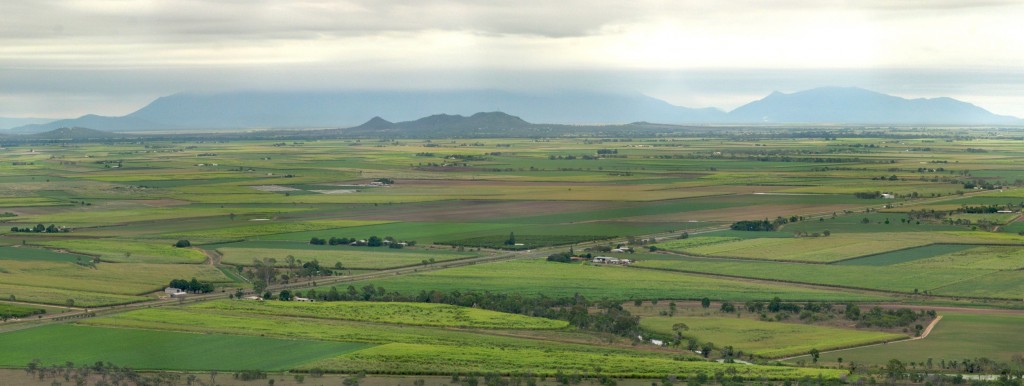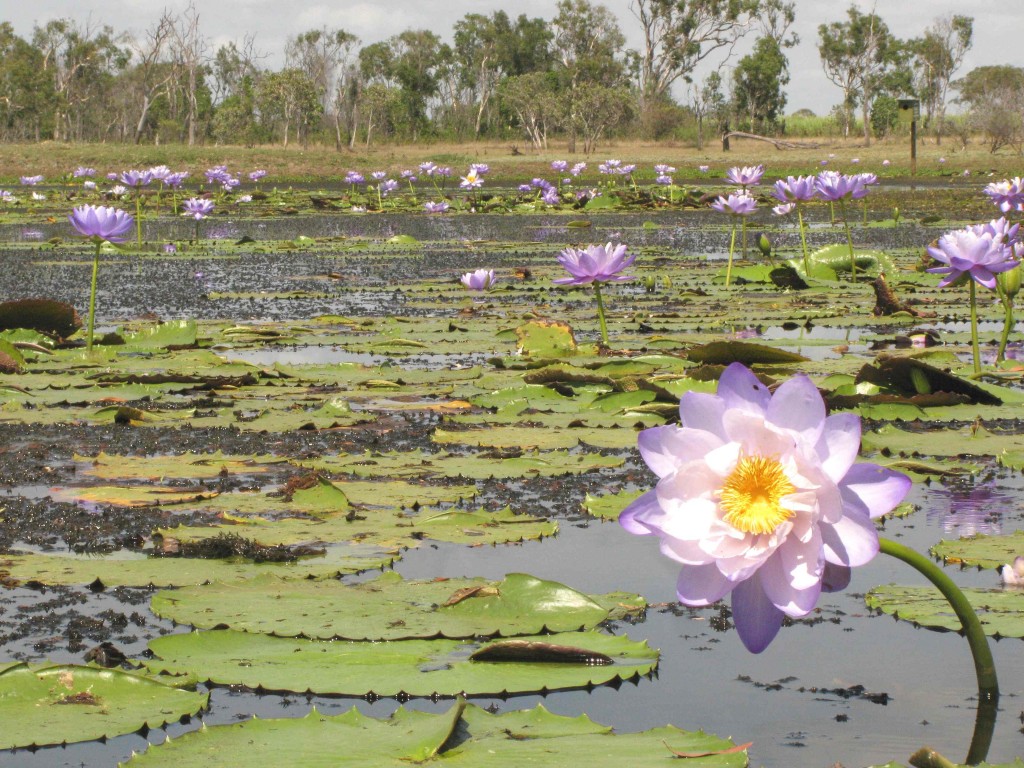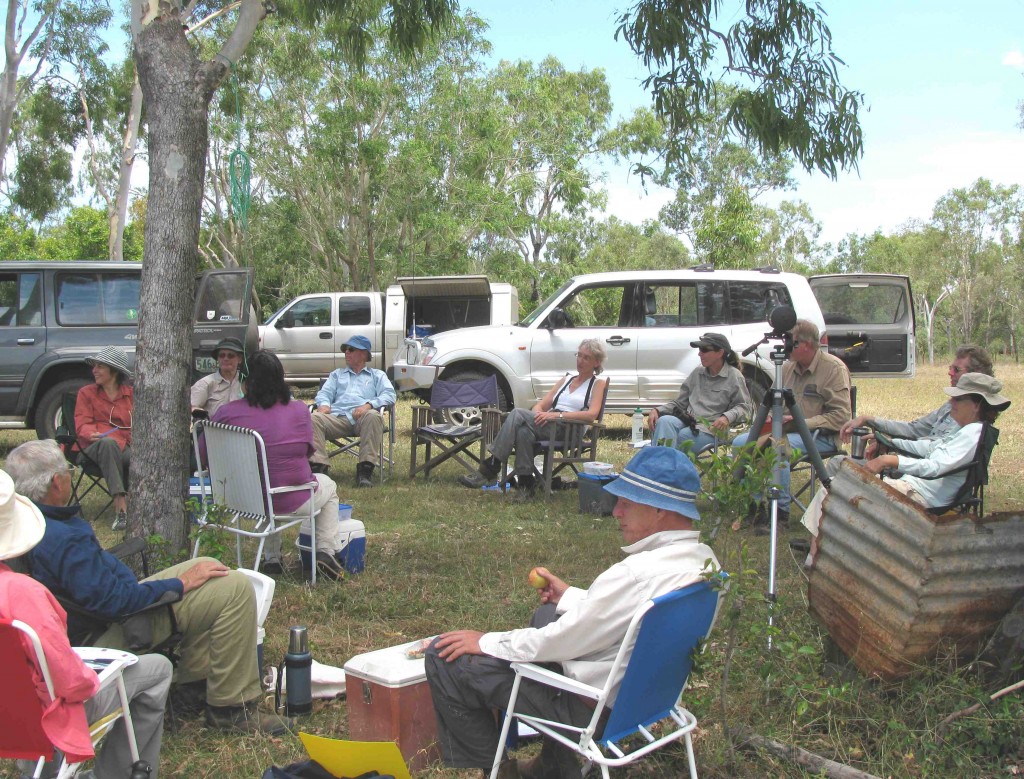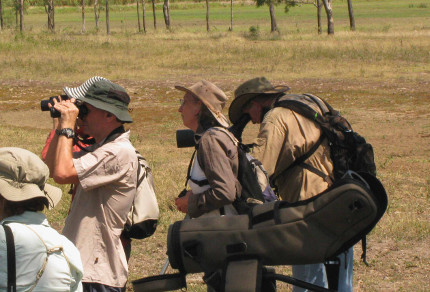
Burdekin Shire viewed from Mount Inkerman (© Vilis Nams)
An hour after sunrise, Vilis and I set off in convoy with other members of the Townsville Region Bird Observers Club, heading south from Townsville past Bowling Green Bay National Park and into the collage of sugarcane paddocks and savannah rangeland of Burdekin Shire. Our destination was Inkerman Station near the base of Mount Inkerman, the station itself a collage of cane and pasture, but possessing a large freshwater wetland lush with reeds, water lilies, and an abundance of waterbirds. The station owners, George and Lyn Spotswood, welcomed us, and George led us on an exploration of the wetland and adjacent woodland with the aim of compiling a species list of birds on the property, of which there were plenty.

Freshwater Wetland, Inkerman Station (© Vilis Nams)
Black swans floated gracefully on the wetland, joined by Pacific black ducks and wandering whistling ducks. Comb-crested jacanas walked the lily pads and called out their anxious, peeping cries. Purple swamphens foraged at the border of a extensive reed bed, and dark-bodied spotless crakes hiding in reeds responded to playback calls, one crake exploding into flight, its legs dangling. A fleet of Australian pelicans rode the water, and royal spoonbills, Australian white ibises, and three egret species – great, little, intermediate – foraged at the wetland borders. Gull-billed terns scouted the wetland with strong wingbeats, while white-winged black terns foraged with more delicate, fluttering flight. Black and whistling kites, as well as white-bellied sea eagles, soared over the water or perched on dead, shoreline trees. We found a turtle shell beneath a massive sea eagle nest crammed onto branches of a tall eucalypt.

Townsville Region Bird Observers Club Members at Inkerman Station, with me in right-centre (© Vilis Nams)
Adjacent to the wetland, Australian (Richard’s) pipits skittered over drying mud and grass, and a singing bushlark with an insect in its beak eyed us warily. Cuckoo-shrikes and willie wagtails hung out in sparse shrubs near a small dam, crimson finches flew like flames among reeds and shoreline shrubs, and a blue-winged kookaburra surveyed us from a perch high in a gum tree.
After a refreshing cuppa in late morning, we walked a dike between a freshwater marsh and a mangrove-edged mudflat. On the latter, we picked up sightings of three shorebirds – a common greenshank probing the mud and then flushing into flight, a common sandpiper that teetered its rump up and down while perched on a dead branch, and a diminutive red-capped plover that raced over the mud. A secretive songbird hidden in a grove of mangroves taunted us with its lilting song and fleeting glimpses of movement until it was identified – amid much excitement – as a yellow white-eye, a species common along the north coast of Australia, but also existing in an isolated colony in the region surrounding the mouth of the Burdekin River.1 This bird belonged to that colony, and I counted myself fortunate to have caught one clear look at it – underparts brilliant yellow, upper body olive – before it disappeared among the green and yellow mangrove leaves.
With midday heat pouring down upon us, we retreated to the shade of trees near the freshwater wetland edge. Magpie geese honked nasally from the water while we leisurely ate our lunches and chatted, for a time departing from our focus on birds, although spotting scopes remained at the ready. We learned that George’s father bought the station in 1919, and that, at the age of 70, George is semi-retired, although he continues to hunt dingoes/wild dogs that prey on his livestock. (At one point during our excursion, a young dingo raced straight toward us before swerving into the cover of wetland reeds.) A keen birder himself, he pointed out a pied imperial-pigeon’s nest high in a clump of mistletoe growing in a gum tree near our picnic area, and extended an open invitation to any of us who might want to camp there beside the wetland and seek out more birds. Now, that’s Aussie hospitality.

Picnic Lunch for Birders at Inkerman Station, with me in centre back (© Vilis Nams)
My birds from Inkerman Station outing: pied imperial-pigeon, little black cormorants, comb-crested jacanas, koel, intermediate egret, blue-faced honeyeater, Australian pelicans, black-faced cuckoo-shrikes, Pacific black ducks, little egrets, magpie geese, Australian white ibises, wandering whistling ducks, black kites, whistling kites, little pied cormorants, varied triller, pheasant coucal, white-bellied sea eagles, yellow-bellied sunbirds, royal spoonbills, crimson finches, gull-billed tern, purple swamphens, Australian pipits, black-fronted dotterels, golden-headed cisticolas, *spotless crake, pied cormorant, black swans, *singing bushlark, *white-winged black tern, brolgas, peaceful doves, Torresian crow, anhinga, willie wagtail, white-bellied cuckoo-shrike, brown-backed honeyeater, spangled drongo, blue-winged kookaburra, mistletoebird, white-faced heron, welcome swallows, common greenshank, common sandpiper, red-capped plover, great bowerbird, Brahminy kite, Nankeen kestrel, *yellow white-eye. (*Denotes lifelist sighting)
Reference:
1. Graham Pizzey and Frank Knight. The Field Guide to the Birds of Australia. 1997. Angus & Robertson, Sydney, p. 512.


